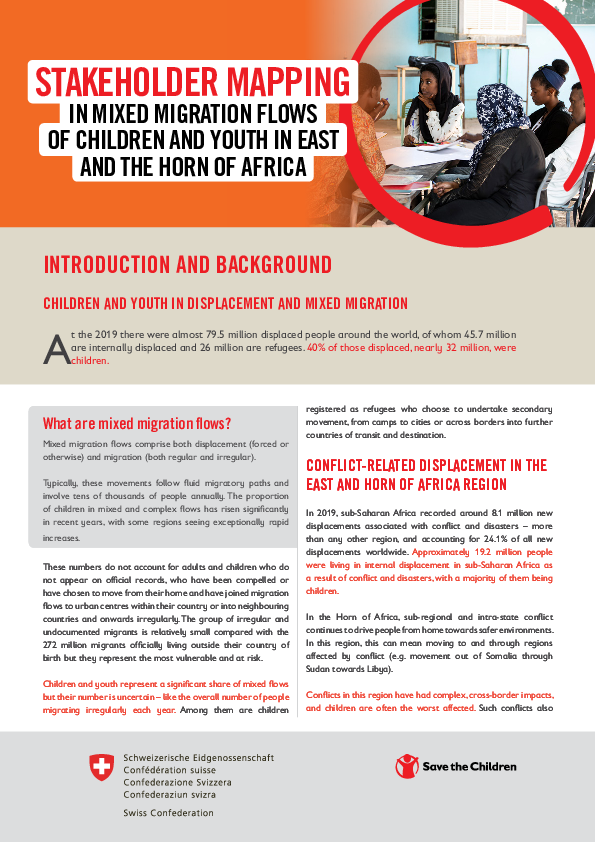
Study: Research
Stakeholder Mapping in Mixed Migration Flows of Children and Youth in East and Horn of Africa
Publication year:
2020
English
Format:
pdf (823.4 KiB)
Publisher:
Save the Children International
Over the past years, the world has witnessed record levels of mixed migration, mainly originating from and hosted within developing countries. Individuals and families migrate for a variety of reasons, some choose to leave to seek education and employment opportunities or to escape poverty, while many are forced to leave their homes, fleeing natural disasters, conflicts and violence, discrimination, or persecution. 70.8 million individuals were forcibly displaced in 2018, 52% of whom are children. Whatever the reason for their journey, migrating children – especially those traveling alone – find themselves extremely vulnerable to a variety of risks, including physical and sexual violence, exploitation, and abuse.
In this context, the Swiss Agency for Development and Cooperation (SDC) has collaborated with Save the Children (SCI) through a four- year programme, to build the protection and self-reliance of children and youth in vulnerable displacement situations along East African migration routes, starting with Egypt, Sudan and Ethiopia. In order to design evidence based intervention, four regional research pieces were undertaken to inform programme development and design. The findings and conclusions served to support the development of relevant interventions along the route, ensuring that SCI’s activities will reach the most vulnerable children and youth and effectively strengthen their self-reliance and address acute protection needs.
This mapping of stakeholders is intended to strengthen the understanding of the formal and informal actors – ranging from family, community, smugglers, officials, fellow migrants, the diaspora, to agencies, government departments, service providers – relevant to the East African Migration Routes (EAMR) programme. The study provides an overview of the international normative framework for migration of children and young people, as well as regional initiatives and policies impacting children on the move in the IGAD region and East Africa. It also examines national legislation, policy, and implementation in the three countries under study, and how this work is meant to impede or support the protection and movement of children and youth migrants. Subsequently, the research examines a range of stakeholders, actors, and processes that child migrants encounter before they leave, and during their journey, with a broadly routes-based lens. These include considerations around information, funding, and risk assessment before leaving, the role of the diaspora, fellow migrants, smugglers, criminal gangs, and officials in the countries of transit or destination. There is also a focus on stakeholders in border areas, and those who are featured in the city environments of Addis Ababa, Khartoum and Cairo, where child and young migrants pass through, or stay.
The publication is part of the series conducted simultaneously. It was spearheaded by Save the Children’s East and South Africa Regional Office, Regional Programme Unit.
Read full abstract
View & Download
Document information
Publisher
Format
Content type
Region
Rights
© Author/Publisher
Found a mistake? Help us improve!
If you have noticed a document assigned to the wrong author or any other inaccuracies, let us know! Your feedback helps us keep our data accurate and useful for everyone.
Share
Link
